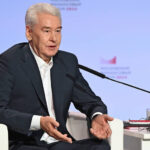Exhibition of Moscow’s Achievements Opens at Gostiny Dvor
The annual festival « Territory of the Future. Moscow 2030 » has begun in Moscow, dedicated to the capital’s development, modernization plans, and contemporary urban life. During the first weekend after the opening, one of the flagship venues at Gostiny Dvor was visited to explore how the city’s future is envisioned by the Moscow government and whether this vision aligns with residents’ expectations.
The exhibition organizers aimed to showcase the scale of changes taking place in the city
The theme of the exhibition at Gostiny Dvor is « Endless Development with Eternal Values. » The first « eternal value » visitors encountered was a half-hour queue at the entrance. On Saturday evening, the line stretched from the corner of Ilyinka Street to the main entrance.
Upon entering, visitors realized they had come in from the wrong side—the main entrance, where the exhibition chronologically begins, is on the opposite side of Varvarka Street, through beautiful arches bearing the slogan « Moscow—City of the Future. » This entrance was so unusual for Muscovites that there were no queues there on Saturday. Yet, even from the « wrong » side, another Moscow « value » was immediately noticeable. « Oh, the scale! » exclaimed one woman upon seeing the towering human figures several stories high installed at the center of the exhibition. Equally gigantic hands seemed to part the exhibition’s curtains, making passersby uneasy as their heads barely matched the size of a pinky fingernail on these hands.
Those who entered from the « correct » side (from Varvarka Street) were greeted by staff with guidebooks explaining each zone of the exhibition. Unsure if anyone would actually read them, they invited everyone to join guided tours.
The tour guide introduced the exhibition by paraphrasing the words of Moscow’s deputy mayor, who said the organizers « wanted to create a space where everyone could take a break from daily hustle, even if just briefly. »
This introduction took place in front of a massive installation called « Windows of Opportunity. » The composition featured a wall with illuminated windows, each symbolizing an opportunity available to Muscovites. Mannequins—gray figures representing people striving for these opportunities—climbed ropes toward the windows. Notably, windows labeled « Moscow longevity, » « new skills, » and « launching a successful career » were easier to reach than those near the ceiling, such as « new healthcare standards, » « education, » and « digital services. »
In the technology zone, among flashing statistics about hospitals and schools renovated in recent years, models of buildings still under construction were displayed. For example, visitors could see the future appearance of the renovated Sklifosovsky Research Institute and new colleges being built. Representatives on-site promoted enrollment, highlighting high employment rates and partnerships with industry leaders. However, younger visitors were more intrigued by other things. A first-grade boy bombarded a college student with questions about operating subway cars and « building cars. » The student, though friendly, later admitted he had actually studied tourism.
The « health » zone was the most crowded.
One display discussed proper nutrition. An overweight man’s heart was depicted as soda cans, while a fit athlete’s heart was hidden behind rib-like steaks. Nearby hung « Moscow’s Health Rules, » which, according to the exhibition’s logic, residents should follow—such as « think positively, » « maintain social connections, » « get enough sleep, » and « avoid stress. » One visitor photographed the rules and joked, « Good thing they don’t fine you for breaking these. They’ve been replacing asphalt outside my window all summer—I haven’t slept well in ages. » Others laughed in agreement.
The main attraction in the health zone was the « Human Body » museum, with a queue stretching across the entire second floor. « It was incredibly popular last year, and now it’s just as busy, » said a staff member managing the crowd. « We’ve upgraded it. Before, our ‘human’ was completely healthy. Now, half the organs show common diseases. » The 15-minute wait led visitors through a journey starting at the mouth and ending at the rectum, making it a hit with teenagers. « Look, smoker’s lungs, smoker’s tonsils! » they giggled.
Few made it to the « knowledge » zone after the museum.
Here, visitors could answer 21 quiz questions, such as «



